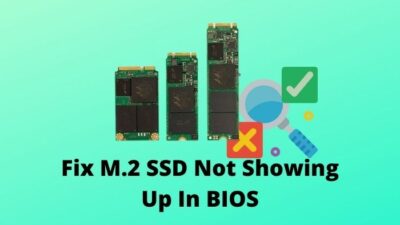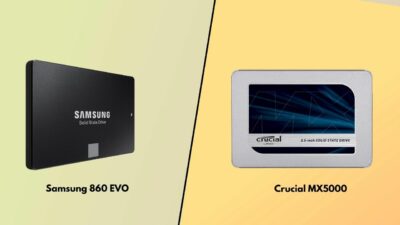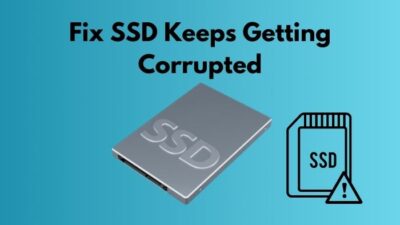Suppose you buy a laptop, you want to boot it. Whilst booting, you learn that you have a storage device called SSD in your system. But can’t figure out, which one is it & what type is it.
I know it can be very infuriating at times and most of us have gone through this. But fear not. I, your friendly TEXPERT (tech-expert) am here to help you identify what storage and type of that storage you have with the help of my 10+ years of experience in the tech field.

SSDs have different types along with different variations of storage capacity to work with. Before moving on to finding out what SSD you have, if you want to utilize it properly or you want to upgrade it, we need to know a few basics.
What is an SSD?
Solid State Drive is the new generation of storage devices used in computers. SSD’s are much faster than your daily traditional mechanical hard disk. It works as a simple USB flash drive but is a much more complex and larger device that accumulates tons of NAND flash storage.
Unlike HDD (Hard Disk Drive), SSDs don’t possess moving parts or spinning disks. To deliver higher speed, even from HDD, SSD controller manages & uses interconnected pools of flash memory to deliver speed beyond the offerings of HDD.
The WOW’s of SSD!
HDD write speeds range between 50-120Mbit/sec, compared to 200-500Mbit/sec of SSD. Meaning that SSD reduces boot time to approx. 10 seconds (in cases much faster) than 35-40 seconds in an HDD.
Boot your operating system on your SSD, click on the power button, and boom, the system has already been opened within 5-10 seconds. You won’t even have the chance to grab some snacks in between.
Types of SSD – Explained
When you decide to go for SSD as the storage device for your setup, you need to consider the speed, readability, and power usage of the SSD. As SSD is extra storage unit using flash memory to store data inside it, it is several times faster than your average HDD in terms of reading and writing data.
As you will notice a reduction in your boot time and application loading time, it will feel much smoother.
There are two types of SSD – SATA & Peripheral Component Interconnect Express or Non-Volatile Memory Express (PCIe/NVMe/PCIe-NVMe).
1. SERIAL ADVANCED TECHNOLOGY ATTACHMENT SSDs (SATA)
Between the two types of SSD, SATA is the slower one because it uses the same interface similar to Hard Disk Drives. Despite being the slowest grade in its criteria, it will still boost up your system’s speed, four to five times than any HDD would.
Also, check out our separate post on will SSD reduce high disk usage.
The most common type is the 2.5inch SATA SSD. It can be used in older generation computers as a separate unit of storage.
The maximum speed is set at 6Gbps / 600Mbps and the average is at 500-500Mbps
MINI-SATA SSDs
Mini SATA or mSATA is the younger brother, smaller in size of SATA SSDs. They are mainly used in smaller devices such as phones, tablets, or very thing laptops and notebooks. They are just smaller in size but have the same specs as a 2.5inch SATA SSD.
Check out our separate post on SSD good for Gaming.
M.2 SSDs
M.2 SSDs are ram-like edition SSDs for your device. It is a rectangular stick looking very similar to a RAM stick, commonly used in mobile devices or slims laptops.
Computers also support M.2 SSDs but your motherboard has to have the designated slot for it. Which can only be found in newer generation boards and a few previous generations too.
Don’t be fooled by their size. M.2 SSDs can store up to 2TB (terabytes) of data. There are also 1TB/512GB/256GB/128GB/120GB editions of it.
You will notice numbers which are M.2 SSD – 2242, 2260, 2280, 22110. These indicate its size in length and width. Example, an M.2 2260 means 22mm (length) X 60mm (width).
Follow our guide to know Can SSD Overheat.
2. PERIPHERAL COMPONENT INTERCONNECT EXPRESS SSDS (PCIe)
PCIe SSDs are three to four times faster than normal SATA SSDs, as it has more bandwidth, meaning it is the fastest type of SSD in the market.
PCIe SSDs are high-speed interface and performance expansion cards installed in the motherboard. It works along well with graphics cards and sound cards. These cards are expensive than SATA SSDs for performance, not for more storage capacity.
In a hurry? Check out my new post on Is SSD Affected by Magnets.
NON-VOLATILE MEMORY EXPRESS SSDs (NVMe)
These are new generation SSDs that possess the fastest response time and best performance.
NVMe can transfer data at a high speed, around 3000-3500 Mbps/ 3-3.5Gbps. Meaning it will take 15 seconds or less to transfer a 30GB file to your computer.
But how do I know what SSD do I have?
There are a few steps that can be performed to identify your storage type. Here are a few simple methods you can follow:
Method 1 – Use PowerShell (Command Line)
Using PowerShell is the quickest and most convenient way to determine the storage device installed on your computer. You need to:
- Click Windows Button + R keyboard shortcut
- Run box will pop-up. Type PowerShell. This will open PowerShell.
- Run the following command:
Get-Physical Disk or
PowerShell “Get-Physical-Disk | Format-Table –AutoSize”
The following texts will indicate the type of storage that is installed under media type.
Method 2 – Use Drive Optimizer Tool
Another recommendation to determine your storage device is by the Drive optimizer tool in Windows, which indicates the disk type including listing the installed drives in the system.
Just simply:
- Click Windows Button + R keyboard shortcut
- Type dfrgui & press Enter.
When the Drive optimizer tool/ Disk Defragmenter window will pop up, look for the media type column to find out your storage type.
Method 3 – Windows Information System Tool
The windows information system tool is a built-in tool in Windows that is available in versions 7,8,10 & 11.
To access the tool, you need to:
- Click Windows Button + R keyboard shortcut
- Type msinfo32 in the Run Box
- A new window will open. You have to expand to Components > Storage > Disks from the left-hand menu.
- You will have detailed information about every hard drive that is attached to your system in the right-hand pane. The information is not shown with headings, so you will have to find out the details of the hard drive with care.
How to tell if I have an SSD in older Windows versions?
There is another way through which you can identify your storage device type. It’s to go to the Computer Management option. Here is how:
- Right-click on My Computer (Windows 7) / This PC (Windows 8/8.1/10/11) and select Manage.
- Click Device Manager > Disk Drives. You will see your hard drive disk on the given list.
If you can’t determine your storage type from here, there is nothing to worry about at all. Just google the detailed information you saw or from the official sites of the devices to know if it’s an HDD or SSD?
How do I know if the SSD is 2.5 SATA or M.2?
Unfortunately, there are no 100% foolproof methods to check if the drive is 2.5inch SATA or M.2 by using any windows programs if the product does not show it in the descriptions of PowerShell or Drive Optimizer.
The only thing that can be done in this case is to open up the laptop/desktop and check. Most laptops open a small access plate from where you can gain access to the drives and RAM without having to pull apart the whole laptop.
Apart from the mentioned methods, there are multiple other ways of opening PowerShell, Driver Optimization tool by using Cortana or using the start menu. But the above-stated methods are the easiest and shortest way to find and identify your storage device.
Also check our exclusive tutorial on can SSD Improve FPS.
Take Away
If you are a gamer and want to enhance your gaming experience then SSD is a must requirement for you, depending on your budget. If your daily need is not gaming but productivity/office work, SSDs will satisfy your need, in a better manner than any high-end HDD.
If you are confused that which storage drive you have in your system, you can follow the methods and find it out yourself without asking for additional help.
If you have any thoughts, please feel free to comment below.




